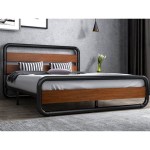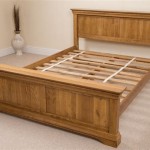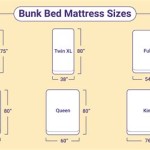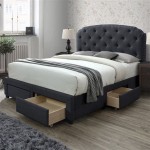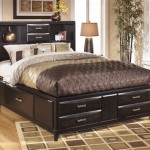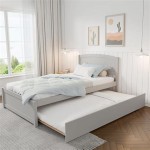What Size Rug Goes Under a Queen Size Bed?
Selecting the appropriate rug size for a queen-size bed is a crucial aspect of bedroom design. The right rug can anchor the bed, define the space, and contribute significantly to the overall aesthetic and comfort of the room. Choosing the wrong size, conversely, can make the room feel disproportionate, cluttered, or unfinished. Therefore, understanding the standard rug sizes and the factors influencing the ideal choice for a queen-size bed is essential for achieving a harmonious and visually appealing bedroom.
A queen-size bed typically measures 60 inches in width and 80 inches in length (5 feet by 6 feet 8 inches). However, the actual dimensions can vary slightly depending on the manufacturer and design. Consequently, it is advisable to measure the exact dimensions of the bed frame, rather than relying solely on the standard queen size, to ensure accurate rug selection. This measurement serves as the foundation for determining the appropriate rug dimensions needed to achieve the desired visual effect and functional purpose.
Several rug placement styles are commonly employed, each yielding a different visual effect and impacting the perceived size and layout of the room. These styles include: all legs on the rug, floating the rug, and partial bed coverage. Each style presents its own considerations for choosing the appropriate rug size, influencing the overall aesthetic and functionality of the space.
All Legs on the Rug
This approach necessitates a larger rug that encompasses the entire bed frame and ideally extends beyond the nightstands on either side. This design creates a cohesive and luxurious feel, grounding the entire sleeping area and visually expanding the space. The most common size for this style is an 9x12 rug. An 8x10 rug could also work depending on the size of the bedroom and placement of the furniture.
To achieve this layout, the rug must be large enough to accommodate the bed frame and nightstands, with sufficient overhang to provide visual balance and ease of movement around the bed. A minimum of 18-24 inches of rug extending beyond the sides and foot of the bed is generally recommended. With a 60-inch wide bed and two 24-inch wide nightstands, you would need at least 108 inches total width. A 9x12 (108x144 inches) rug or an 8x10 (96x120 inches) would provide enough space for the bed and nightstands, but an 8x10 rug would have the nights stands off the rug. The length of the rug should accommodate the 80-inch length of the bed and the desired extension at the foot of the bed, typically 18-24 inches.
Larger bedrooms benefit most from this rug placement style, as the extensive rug coverage can visually unify the space and create a sense of grandeur. In smaller bedrooms, however, a rug that is too large can overwhelm the room and make it appear cramped. For smaller rooms, consider strategically positioning the rug to cover the front two-thirds of the bed, leaving the headboard against the bare floor or wall.
Floating the Rug
This style involves placing only the front two legs of the bed on the rug, while the back legs remain on the bare floor. This is a more cost-effective option as it requires a smaller rug. It is often favored in smaller bedrooms or when budget constraints are a consideration.
To determine the ideal rug size for floating placement, measure the width of the bed frame and add at least 18-24 inches on each side to ensure a balanced and visually appealing overhang. The length of the rug should extend far enough past the foot of the bed to provide adequate coverage and visual balance. A common choice for this style is a 6x9 rug or 8x10 rug depending on the size of the room and desired aesthetic.
For a queen-size bed, a rug measuring 6x9 feet or 8x10 feet is typically sufficient for the floating style. This size allows the front legs to rest comfortably on the rug while leaving a generous portion of the rug exposed in front of the bed, creating a focal point and defining the seating area.
This placement style is particularly effective in bedrooms with hardwood or tile floors, as it adds warmth and texture to the space without completely covering the flooring. It also allows the beauty of the flooring to remain visible, creating a balanced and visually appealing design.
Partial Bed Coverage
This placement has the rug placed mostly in front of the bed providing comfort and warmth for your feet in the mornings. The best rug sizes for this is either 5x8 or 6x9 rug.
This rug size is also more affordable than the larger rug sizes. This placement helps define the space and provides coverage where you need it most.
This is a budget friendly option that is great for smaller rooms.
Considerations Beyond Bed Size
While the size of the queen bed is a primary factor in rug selection, several other considerations play a significant role in determining the ideal rug size. These include the overall room size, the placement of other furniture, the desired aesthetic, and the functionality of the space.
The overall room size dictates the maximum rug size that can be accommodated without overwhelming the space. In smaller bedrooms, a larger rug can make the room appear cramped and cluttered, while in larger bedrooms, a smaller rug can appear insignificant and out of proportion. Therefore, it is essential to consider the overall room dimensions and choose a rug size that complements the space without dominating it.
The placement of other furniture, such as nightstands, dressers, and chairs, also influences the ideal rug size. If nightstands are used, the rug should ideally extend beyond the sides of the nightstands to create a cohesive and unified look. If a dresser is positioned at the foot of the bed, the rug should extend far enough to accommodate the dresser legs, ensuring that the furniture is grounded on the rug.
The desired aesthetic is another crucial consideration. A larger rug that encompasses the entire bed and nightstands creates a luxurious and cohesive feel, while a smaller rug that only covers a portion of the bed creates a more casual and relaxed vibe. The choice of rug size should align with the overall design style and aesthetic preferences of the homeowner.
The functionality of the space also plays a role in rug selection. If the rug is intended to provide warmth and comfort underfoot, a larger rug that extends beyond the bed is preferable. If the rug is primarily intended to define the space and add visual interest, a smaller rug may suffice. The functional purpose of the rug should be considered when determining the appropriate size and placement.
The style and pattern of the rug also influence the perception of size and space. A rug with a bold pattern or bright colors can make a smaller room appear larger, while a rug with a subtle pattern or neutral colors can create a more calming and serene atmosphere. The choice of rug style and pattern should complement the overall design of the room and enhance the desired aesthetic.
Ultimately, selecting the appropriate rug size for a queen-size bed involves a careful consideration of various factors, including the bed size, room size, furniture placement, aesthetic preferences, and functional requirements. By taking these factors into account, one can choose a rug that not only enhances the visual appeal of the room but also provides comfort, warmth, and functionality.
The color of the rug should complement the existing color scheme of the bedroom. Consider the color of the walls, bedding, and furniture when selecting a rug color. Neutral colors such as beige, gray, and ivory are versatile options that can blend seamlessly with various color palettes. Bold colors such as blue, green, and red can add a pop of color and visual interest to the room. The choice of rug color should align with the overall design style and desired aesthetic.
The material of the rug influences its durability, comfort, and maintenance requirements. Natural fibers such as wool, cotton, and jute are durable and environmentally friendly options. Synthetic fibers such as nylon, polyester, and polypropylene are more affordable and stain-resistant. The choice of rug material should be based on the desired level of durability, comfort, and maintenance.
The pile height of the rug affects its comfort and appearance. High-pile rugs are soft and luxurious, while low-pile rugs are more durable and easier to clean. The choice of pile height should be based on the desired level of comfort and the expected level of foot traffic. For bedrooms, a medium-pile rug is generally a good compromise between comfort and durability.

What Size Rug Do You Need For A Queen Bed Tsar Carpets

Everything To Know About Placing A Rug Under Your Bed

Rug Under Bed Sizes King Queen Double Child Images

How To Choose The Best Rug For Under Your Bed 136 Home

Rug Size For Bedroom With Queen Bed Guide Placement

What Size Area Rug For Queen Bed Dingmun

What Size Rug Should I Use Under A Bed Mcqueens Interiors

Attractive 5x7 Rug Under Queen Bed Images Luxury For B Bedroom Placement Size King

What Size Rug Goes Under A Bed In My Own Style

Bedroom Rug Guide Pottery Barn Australia

